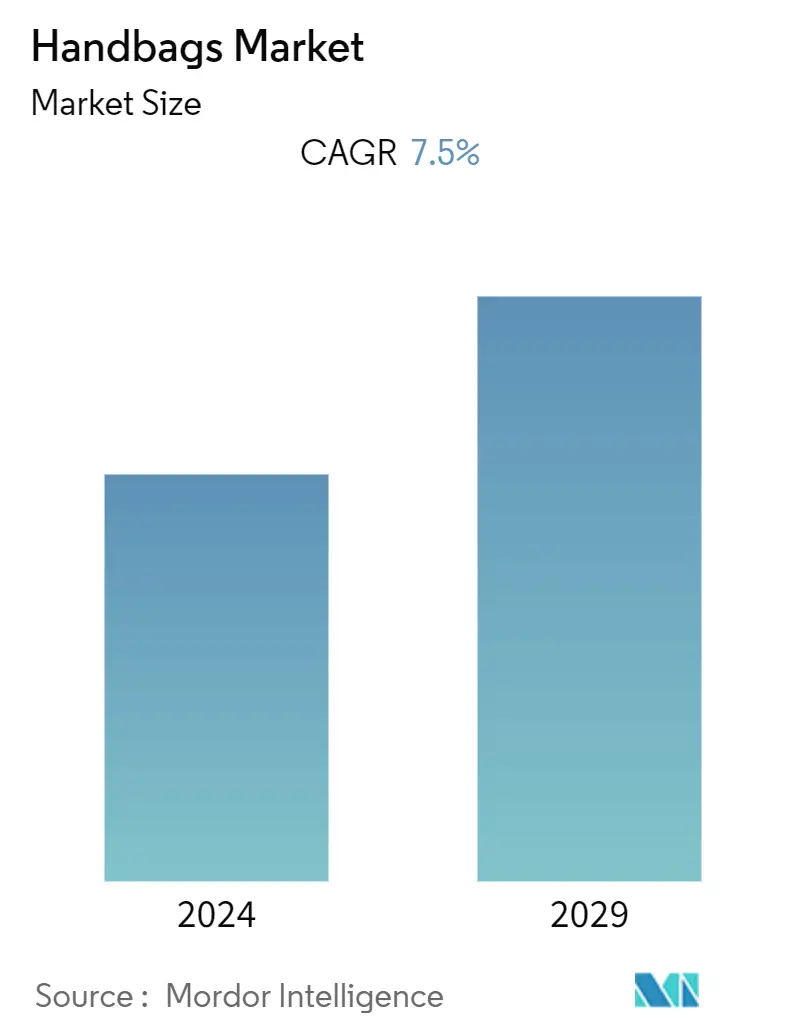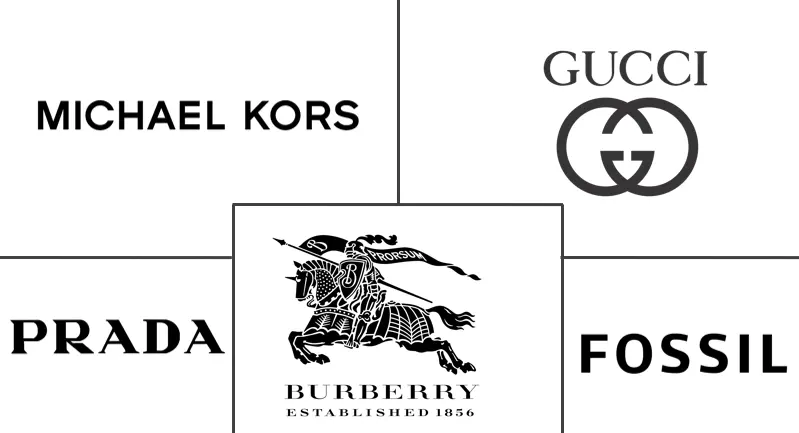Market Size of Handbags Industry

| Study Period | 2019 - 2029 |
| Base Year For Estimation | 2023 |
| CAGR (2024 - 2029) | 7.50 % |
| Fastest Growing Market | Asia Pacific |
| Largest Market | North America |
| Market Concentration | High |
Major Players
*Disclaimer: Major Players sorted in no particular order |
Handbag Market Analysis
The Handbags Market is expected to register a CAGR of 7.5% during the forecast period.
- The growing adoption of luxury wear, high purchasing power, and the influence of celebrity endorsement are driving the market growth. The bag industry is highly competitive and requires continuous innovation and development, especially in the case of product design and improvement, to keep up with changing consumer trends. Further, customers, particularly millennials and Gen Z, are becoming more open to premium fashionable accessories, including handbags, and are willing to experiment with various branded superior fashion accessories due to evolving fashion perceptions and increased exposure to global fashion trends.
- In addition, key players focus on strategic partnerships and expansions to cater to the growing demand, especially for luxury handbags. The ever-increasing fashion industry drives the handbag market, with bags considered a major fashion statement. Also, due to the increasing social media influence on the purchasing behavior of consumers, companies are targeting their product ranges through e-commerce channels. However, the presence of counterfeit products is a critical challenge brands face globally.
Handbag Industry Segmentation
A handbag is used to carry personal items or accessories and comes in various sizes and designs.
The handbag market is segmented by product type, distribution channel, and geography. By product type, the market has been segmented into satchel, bucket bag, clutch, tote bag, and other product types. By distribution channel, the market has been segmented into online retail stores and offline retail stores. By geography, the market has been segmented into North America, Europe, Asia-Pacific, South America, and Middle-East and Africa.
The market sizing has been done in value terms in USD for all the abovementioned segments.
| By Product Type | |
| Satchel | |
| Bucket Bag | |
| Clutch | |
| Tote Bag | |
| Other Product Types |
| By Distribution Channel | |
| Online Retail Stores | |
| Offline Retail Stores |
| Geography | |||||||||
| |||||||||
| |||||||||
| |||||||||
| |||||||||
|
Handbags Market Size Summary
The handbag market is experiencing robust growth, driven by the increasing adoption of luxury wear and the influence of celebrity endorsements. The industry is characterized by intense competition, necessitating continuous innovation in product design to align with evolving consumer trends. Millennials and Gen Z are particularly influential, showing a growing openness to premium fashion accessories and a willingness to experiment with various branded products. The fashion industry, with bags as a significant fashion statement, is further propelled by the rising influence of social media on consumer purchasing behavior. Companies are leveraging e-commerce channels to reach a broader audience, although the challenge of counterfeit products remains a concern.
In Europe, the handbag market is fueled by evolving fashion trends and a shift towards personalized products, with key players offering customized handbags to expand their customer base. The convenience of online shopping has led to a preference for e-commerce platforms, with international tourism also supporting sales. The market is competitive, with major players like Burberry, Prada, Fossil Group, Michael Kors, and Gucci dominating through product innovations and strategic expansions. The trend towards sustainable fashion is influencing brands to adopt vegan materials, as seen with the introduction of vegan leather handbags. Companies are focusing on advanced distribution networks and continuous innovation to meet rapidly changing consumer demands.
Handbags Market Size - Table of Contents
-
1. MARKET DYNAMICS
-
1.1 Market Drivers
-
1.1.1 Fast Fashion Trend
-
1.1.2 Inflating Income Level of Individuals
-
-
1.2 Market Restraints
-
1.2.1 The Presence Of Counterfeit Products
-
-
1.3 Industry Attractiveness - Porter's Five Forces Analysis
-
1.3.1 Threat of New Entrants
-
1.3.2 Bargaining Power of Buyers/Consumers
-
1.3.3 Bargaining Power of Suppliers
-
1.3.4 Threat of Substitute Products
-
1.3.5 Intensity of Competitive Rivalry
-
-
-
2. MARKET SEGMENTATION
-
2.1 By Product Type
-
2.1.1 Satchel
-
2.1.2 Bucket Bag
-
2.1.3 Clutch
-
2.1.4 Tote Bag
-
2.1.5 Other Product Types
-
-
2.2 By Distribution Channel
-
2.2.1 Online Retail Stores
-
2.2.2 Offline Retail Stores
-
-
2.3 Geography
-
2.3.1 North America
-
2.3.1.1 United States
-
2.3.1.2 Canada
-
2.3.1.3 Mexico
-
2.3.1.4 Rest of North America
-
-
2.3.2 Europe
-
2.3.2.1 Germany
-
2.3.2.2 United Kingdom
-
2.3.2.3 France
-
2.3.2.4 Russia
-
2.3.2.5 Spain
-
2.3.2.6 Italy
-
2.3.2.7 Rest of Europe
-
-
2.3.3 Asia-Pacific
-
2.3.3.1 India
-
2.3.3.2 China
-
2.3.3.3 Japan
-
2.3.3.4 Australia
-
2.3.3.5 Rest of Asia-Pacific
-
-
2.3.4 South America
-
2.3.4.1 Brazil
-
2.3.4.2 Argentina
-
2.3.4.3 Rest of South America
-
-
2.3.5 Middle-East and Africa
-
2.3.5.1 South Africa
-
2.3.5.2 Saudi Arabia
-
2.3.5.3 Rest of Middle-East and Africa
-
-
-
Handbags Market Size FAQs
What is the current Global Handbags Market size?
The Global Handbags Market is projected to register a CAGR of 7.5% during the forecast period (2024-2029)
Who are the key players in Global Handbags Market?
Michael Kors, Burberry Group PLC, Prada Holding BV, Fossil Group, Inc. and Guccio Gucci S.p.A are the major companies operating in the Global Handbags Market.

